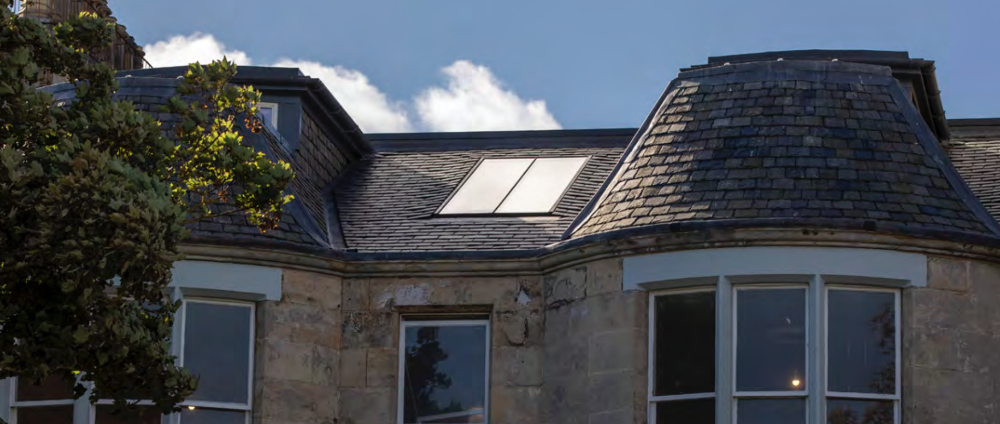The properties of conservation rooflights
[edit] What is a conservation rooflight?
If you have ever needed conservation rooflights for your project, the chances are that you have searched online and found plenty of choice. But what is a conservation rooflight and are they all the same?
To better understand what makes a rooflight a conservation style, we must grasp the history behind this type of glazing and why the design is so sought after, not just on period properties but on more modern projects too.
Without the ingenious concept of a rooflight, transforming unconventional space into a well-lit property would be a daunting task, and in some cases impossible. Although rooflights, or skylights as they are sometimes known, have been around for centuries, they became more prominent during the Victorian era as technology and building aspirations were stretched and roof glazing boomed. One of the most famous Victorian building projects was Crystal Palace which, in 1851, used glazing on an unprecedented scale to showcase what could be achieved.
Mass-produced Victorian rooflights for residential use tended to be made from cast iron and had smaller, lighter panes of glass. This was partially down to limits of glass technology, but also because of excise duties, which were imposed on glass by weight at the time. These slim, single glazed rooflights with multiple panels of glass were unobtrusive in design and sat flush in the roof. Today, it is this minimalist appearance that many seek to achieve with their glazing designs.
As a result of their popularity, there are lots of conservation roof windows on the market, which can make choosing the right one virtually impossible, unless one can identify what the differentiations are. An effective way to make this distinction is to look closer at the attributes of a true replica of a Victorian conservation rooflight.
[edit] What material is the conservation rooflight manufactured from?
If a conservation rooflight is all frame, then there is little point in having one. Genuine conservation designs should be manufactured with slim, clean lines and a low-profile to match the roofline. A number of skylight companies try to produce conservation rooflights using modern, bulky aluminium profiles. It is widely accepted that most authentic conservation rooflights are manufactured from steel because the material provides great strength while offering a slim profile and excellent glass-to-frame ratios.
[edit] Single or double glazed?
Victorian rooflights would have been single glazed, but today’s modern building standards are much higher and so single glazing does not meet the minimum requirements for thermal efficiency. Double glazing is the most popular option for genuine conservation rooflights because glazing technology means modern double glazed units can provide a number of benefits while remaining reasonably slender.
Some conservation rooflight suppliers are keen to boast about offering triple glazing in their products, but while this does offer a slightly improved thermal performance, it comes at the expense of appearance. The optimal spacer bar thickness is 16 millimetres, so any decent triple glazed unit is going to be almost 50 percent thicker than a double glazed version. With a flush fitting profile being one of the main requirements of a conservation rooflight, the introduction of triple glazing makes these rooflights almost impossible on some roof types.
[edit] Glazing bars?
It is often a stipulation from the conservation officer that a conservation rooflight should have a glazing bar to replicate that original Victorian appearance. It is not always the case, but it is definitely worth checking whether you need them before purchasing a conservation rooflight.
If your conservation rooflight does require a glazing bar, then it should be a genuine one. This distinction separates those producing close replicas of the original Victorian rooflights and those who are trying to pass off modern skylights as something more traditional. A genuine glazing bar should be something that not only divides the glazing but also provides additional strength to the casement.
[edit] Top hung or centre pivot?
If you are looking for a close replica of a Victorian rooflight then a top hung profile will be the one you should opt for. Not only does a top hung design offer a more authentic appearance, it also maximises the space below due to the casement not sticking into the room. Smaller top hung rooflights also utilise beautiful brass ironmongery to operate the casement, whereas centre pivot designs tend to rely on modern plastic handles, which are out of reach and offer nothing to enhance the internal aesthetics.
[edit] Is any old conservation rooflight suitable for my project?
Just because something is sold as a conservation rooflight, that does not automatically make it suitable for all building types. If your building is listed or in a conservation area then the criteria for using conservation rooflights are much stricter and you should always gain approval, not only for their use but also for the manufacturer that you want to use.
There are only a handful of companies that specifically make conservation rooflights and even fewer who design, manufacture and assemble them in the UK. Many conservation rooflights available online are simply other products which have been spruced up to look like they meet the requirements of that type of product. If you ask a supplier what the main difference is between their conservation rooflight and those used on modern buildings and the answer is a stuck on glazing bar, then you should avoid this supplier at all costs. Likewise, there are many elements which go into a genuine conservation design and price is always a reflection on quality.
[edit] Is there anything else I should consider when choosing my conservation rooflight?
With the UK government pursuing a carbon neutral environment it is imperative that every action is taken to reduce energy consumption. Rooflights are energy efficient as they let in large amounts of natural light, thus reducing the need for artificial lighting. Remember that bringing natural daylight into your home is about much more than creating a bright, welcoming environment, it is about protecting your health and wellbeing and achieving a more positive way of life.
One way to ensure that you maximise the amount of available light is to increase the size of your rooflights… or is it? Having a large rooflight does not always guarantee lots of light and you should always check what the finished viewable (or ‘clear viewable’) area of the rooflight will be. You might think that a conservation rooflight with a frame size of 900 millimetres wide and 1,200 millimetres high would have a similar clear viewable area regardless of the manufacturer, but you would be wrong. Bulky-framed modern types and flat rooflights posing as pitched conservation styles will let in considerably less light than a genuine steel-framed version.
With so many choices available, choosing the right conservation rooflight can be a bit of a minefield, but with proper guidance and advice it need not be a stressful experience.
This article appears in the AT journal issue 150, winter 2024 as 'The unique properties of a genuine conservation rooflight' written by Paul Trace, Director, Stella Rooflight.
--CIAT
[edit] Related articles on Designing Buildings
Featured articles and news
Gregor Harvie argues that AI is state-sanctioned theft of IP.
Experimental AI housing target help for councils
Experimental AI could help councils meet housing targets by digitising records.
New-style degrees set for reformed ARB accreditation
Following the ARB Tomorrow's Architects competency outcomes for Architects.
BSRIA Occupant Wellbeing survey BOW
Occupant satisfaction and wellbeing tool inc. physical environment, indoor facilities, functionality and accessibility.
Preserving, waterproofing and decorating buildings.
Many resources for visitors aswell as new features for members.
Using technology to empower communities
The Community data platform; capturing the DNA of a place and fostering participation, for better design.
Heat pump and wind turbine sound calculations for PDRs
MCS publish updated sound calculation standards for permitted development installations.
Homes England creates largest housing-led site in the North
Successful, 34 hectare land acquisition with the residential allocation now completed.
Scottish apprenticeship training proposals
General support although better accountability and transparency is sought.
The history of building regulations
A story of belated action in response to crisis.
Moisture, fire safety and emerging trends in living walls
How wet is your wall?
Current policy explained and newly published consultation by the UK and Welsh Governments.
British architecture 1919–39. Book review.
Conservation of listed prefabs in Moseley.
Energy industry calls for urgent reform.
Heritage staff wellbeing at work survey.


























